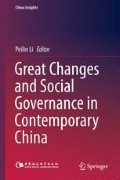Abstract
After more than 30 years of Reform and Opening Up, China has made remarkable achievements in its economic development and became the world’s second-largest economy. The achievements also help China accelerate its economic restructuring and improve the people’s living standard. China’s social structure, as well as its economic development, underwent great changes. The government’s family planning policy (or the one-child policy) together with the people’s attitude and behavior changes in giving birth created a “demographic dividend.” During this period, as the birth rate remained below the replacement level, the child dependency ratio (CDR) declines rapidly and the percentage of working-age population continues to rise. The abundant labor force and low dependency ratio thus boosted the economy. According to experts’ calculation, the “demographic dividend” contributed to over 1/4 of China’s economic growth in its takeoff stage (Cai Fang and Wang Dewen 2005). Obviously, the changes in China’s social structure, especially those in its population’s age structure, had a large influence over its economic development. However, behind the “demographic dividend” also hid a serious social problem—the aging of the population.
Access this chapter
Tax calculation will be finalised at checkout
Purchases are for personal use only
Notes
- 1.
Translator’s note: The American economist Walt Whitman Rostow published the Rostow’s stages of growth model in the 1960s. The model postulates that economic growth occurs in the following five basic stages: traditional society, preconditions for takeoff, takeoff, drive to maturity, and age of high mass consumption.
- 2.
Translator’s note: According to the United Nations, a country is considered as “aged” when 14 % of its population is aged 65 or older.
References
Guo Zhigang, Rethink about Chinese Population Situation, Conference paper (2012)
Liu Ji, Diversed classes and intergeneration: pension politics of European welfare countries. Fujian Tribune 7 (2007)
National Bureau of Statistics of the People’s Republic of China, Chinese Annual Statistic Book in 2011 (Chinese Statistic Press, Beijing, 2011)
Wang Dewen, Zhang Kaiti, Estimated living condition and poverty rate of Chinese aging population. Chin. Popul. Sci. 1 (2005)
Cai Fang, Dewen Wang, China’s demographic transition: implications for growth, in The China Boom and Its Discontents, ed. by K. Garnaut, S. Song (Asia Pacific Press, Canberra, 2005)
Peng Xizhe et al., Viewing China’s aging population from the perspective of public policy (《剬共政策视角下的中国人口老龄化》). Soc. Sci. China 3 (2011)
United Nations, Population aging in China-facts and figures (2006), http://daccess-dds-ny.un.org/doc/UNDOC/GEN/N04/635/82/PDF/N0463582.pdf
Zhu Qngfang, Viewing impoverishment of the aging population from the index system (《从指标体系看老龄人口的贫困化》). Chinese Cadres Tribune 8 (2005)
Author information
Authors and Affiliations
Editor information
Editors and Affiliations
Rights and permissions
Copyright information
© 2016 China Social Sciences Press and Springer-Verlag Berlin Heidelberg
About this chapter
Cite this chapter
Li, P. (2016). Changes in Age Structure Posing Challenges to Social Governance. In: Li, P. (eds) Great Changes and Social Governance in Contemporary China. China Insights. Springer, Berlin, Heidelberg. https://doi.org/10.1007/978-3-662-45734-4_1
Download citation
DOI: https://doi.org/10.1007/978-3-662-45734-4_1
Publisher Name: Springer, Berlin, Heidelberg
Print ISBN: 978-3-662-45733-7
Online ISBN: 978-3-662-45734-4
eBook Packages: Social SciencesSocial Sciences (R0)

